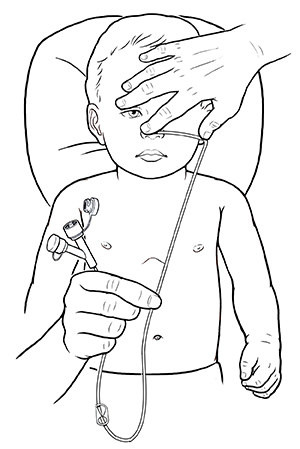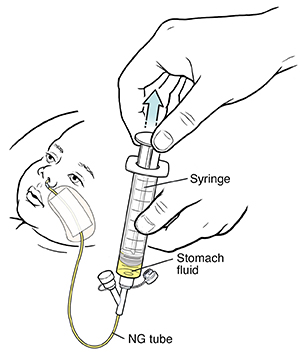Your Child's Nasogastric Tube: Replacing the Tube
Your child is going home with a nasogastric (NG) feeding tube in place. This is a soft thin tube put through your child’s nose and down into the stomach. It sends liquid food directly to the stomach. You were shown how to replace the tube before your child was discharged from the hospital. This sheet will help you remember those steps at home. If you need more help, talk with the hospital about how to arrange a home health nurse to help you.
Keep in mind that there are many types of NG tubes and syringes. Your child’s NG tube and supplies may look or work differently from what are described and shown here. Follow your child's care team's instructions for your child's NG tube.
Note
Take care to keep the tube from becoming a strangulation risk to your child. Follow your healthcare team's advice on how to secure the tube safely.
Contact information to keep handy
Ask for phone numbers to call if you need help. Also make sure you have the phone number for your child’s medical supply company. You will need to order more supplies for your child in the future. Write all of these phone numbers below.
Healthcare provider phone number: ____________________________________
Home health nurse phone number: _____________________________________
Medical supply company phone number: __________________________________
When to replace the tube
Ask your child's healthcare provider how often the NG tube needs to be replaced.
Replace NG tube: _________________________
If your child pulls the tube out before then, you will need to reinsert it. It’s OK to use the same tube if that happens. Just wash the tube with soap and water before you reinsert it. Change nostrils each time you need to insert the tube.
Supplies you will need
-
NG tube
-
Dark-colored marker pen
-
Water-based lubricant
-
Adhesive skin dressing
-
Tape
-
5 to 10 mL syringe
Preparing the tube
-
Wash your hands with soap and water.
-
Look at the tube. One end of the tube is rounded and goes into the nose. The other end has 2 ports. One port is for feeding. The other port is for giving medicines.
-
Check the tube for a wire (metal stylet) inside it. The wire keeps the tube from curling. If your child’s tube has a wire, check that it can be removed easily and doesn’t get stuck.
Measuring the tube
-
Hold the tip of the tube at your child’s nose.
-
Extend the tube to your child’s earlobe. Then, extend it from the earlobe to a spot between the bottom of the breastbone (xyphoid process) and the belly button.
-
Keep your finger on the tube at this spot.
-
Use a dark marker pen to mark this spot on the tube. This shows how much of the tube needs to be inserted before it reaches the stomach.

Positioning your child
-
Ask a family member or friend to hold your child while you insert the tube, if needed.
-
If your child is a baby, wrap them in a blanket to prevent movement.
-
If your child is older, they should sit upright. If possible, have your child tuck their chin slightly toward the chest.
Inserting the tube
-
Put some water-based lubricant on the tip of the tube. This is so it can slide through the nose easily.
-
Gently guide the tube into a nostril. Change nostrils each time you need to insert the tube.
-
The tube is easier to advance when your child is swallowing. An infant can suck on a pacifier as you insert the tube. An older child can drink water or dry swallow. Don’t force the tube. If your child coughs, gags, or has trouble breathing, stop and wait. Allow your child to rest. Then, try again.
-
Advance the tube until the mark you made earlier reaches the child’s nose.
-
Place the adhesive skin dressing on your child’s cheek where you plan to tape the tube. This protects your child’s skin from being damaged by the tape.
-
Tape the tube to your child’s cheek over the adhesive skin dressing, as you were shown in the hospital. This secures the tube in place.
-
If your child’s tube has a wire, remove it at this time. Don’t throw the wire away. In case you need to reinsert the tube, the wire can be reused to keep the tube straight.
Checking the placement of the tube

-
Attach the syringe to the end of the NG tube. Make sure the other port of the tube is closed off.
-
Pull back on the plunger of the syringe until you see liquid from the stomach in the syringe.
-
Look at the color of the fluid. It should look clear or light yellow.
-
Check the pH of the liquid from the stomach using pH paper. Stomach (gastric) pH should be 1 to 5 if your child is not taking a proton pump inhibitor or H2 receptor antagonist. Follow your provider's specific instruction. There are other things that can increase pH.
-
If your child is on continous feedings, you will need to stop the feeding for a short time each day to check tube placement with pH paper. Follow your provider's instructions on how to do this:
_________________________________________________________________________________
-
If you are not sure the tube is in the stomach, don’t proceed with the feeding. Re-insert or gently move the NG tube as you were instructed at the hospital. Repeat the above steps to check for correct placement.
-
Remove the syringe from the feeding tube.
-
Tape the tube securely in place along your child’s nose or cheek as you were shown in the hospital.
-
Wash the syringe out with soap and water and allow to dry.
Tips for caregivers
-
When placing the tube, it may help to talk to your child and explain what you are doing. Say positive words your child after you have placed the tube.
-
When the tube is in place, keep the area around your child’s nose clean and dry. Check the skin around your child’s nose and face regularly to look for soreness or infection.
-
Clean your child’s mouth regularly. Do this even though they aren't taking food by mouth.
-
Make sure to have a backup tube in case a problem occurs with your child’s tube.
When to call the healthcare provider
Call your child's healthcare provider right away if any of the following occurs:
-
You are not able to place the tube.
-
The skin around the tube site has redness, swelling, leaking fluid, or sores.
-
You see blood around the tube, in your child’s stool, or in the contents of the stomach.
-
Your child coughs, chokes, or vomits while feeding.
-
Your child’s belly looks bloated or feels hard when gently pressed.
-
Your child has diarrhea or constipation.
-
Your child has a fever 100.4°F ( 38°C) or higher, or as directed by your child's healthcare provider.
Call 911
Call 911 if your child has: